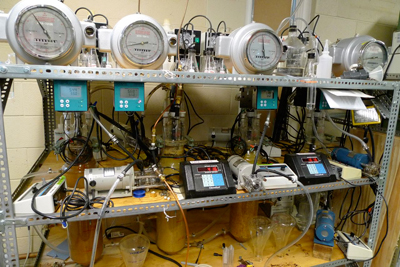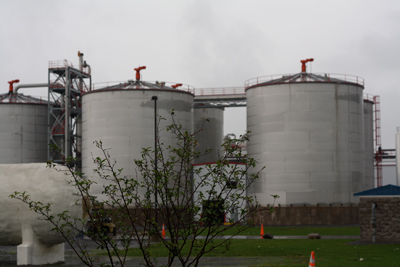Researchers convert 'beer' into a better-than-ethanol biofuel
By Anne Ju


At Cornell, researchers are turning beer into biofuel.
It's not the beer that's good to drink -- but fermentation broth, which is chemically identical to the imbibing beer, from which the fuel ethanol is produced.
Using a mixed bag of microbes for specific chemical reactions, biological engineers have designed a process for upgrading ethanol into something even better -- caproic acid, a carboxylic acid that's a versatile fuel precursor. If scaled up, their process could integrate seamlessly into already-established ethanol production lines.
Largus Angenent, associate professor of biological and environmental engineering, led the study, which was published online June 13 by the Royal Society of Chemistry journal Energy and Environmental Science. The journal has promoted it as a "hot paper."
Ethanol is already a widely used biofuel, but it is expensive to produce because it is water soluble and requires distillation -- an energy-intensive industrial process.
Usually made from corn in the United States, ethanol is produced in large reactors to ferment: enzymes convert cornstarch to sugar, and yeast converts the sugar to ethanol. Chemically identical to beer (and called that in the industry), the broth is not palatable -- drinkable beer has had the yeast filtered out, for starters.
Angenent's group biologically converted ethanol into n-caproic acid using only beer with dilute ethanol. Their microbial mix then converted 2-carbon units into 6-carbon chain acids.
"With fuels you want to have pretty long carbon chains," Angenent said. "Ethanol has two carbons, and you can run a car on that but not a plane -- it's not dense enough."
Caproic acid's advantages over ethanol are many: It's hydrophobic -- it resembles oil droplets -- making it easier to separate from water in the purification process. It's also versatile, with potential use in such diverse applications as animal feed, or as an anti-microbial agent.
The researchers used donated buckets of fermented beer broth from a nearby corn ethanol plant, Western New York Energy, for their experiments. In the lab, they set up 5-liter tanks as the reactors. They mixed the fermentation broth with what biological engineers call an open microbial community -- a sort of mixed bag of billions of microbes of different species, like those found in the human gut. Some of these species can be identified with gene sequencing, but not everything in the microbe community is known.
A key discovery was figuring out how to control the pH and temperature of the broth, so that by extracting the caproic acid simultaneously with production, the researchers could produce enough acid without sacrificing any by conversion to methane.
Scientists had doubted that an open community like this could make anything useful besides methane, but Angenent is showing that's not the case.
"We can shape the community in any way to make the products we want," he said.
The paper's first author is graduate student Matthew T. Agler. The work was supported by the U.S. Department of Agriculture.
Media Contact
Get Cornell news delivered right to your inbox.
Subscribe